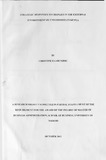| dc.description.abstract | Organizations are environment serving and environment dependent. The environment in
which organizations operate is constantly changing with different factors influencing the
organizations. Coping with the increasingly competitive environment has called on firms
to rethink their strategies. Strategic responses ensure the survival of organizations at large
and at the same time enhance relevance in the environment in which they serve. The
purpose of this study was to establish the strategic responses to changes in the external
environment by universities in Kenya. The objectives of the study were to determine the
challenges facing universities in Kenya that emanate from the external environment and
to establish strategic responses by the universities in Kenya to effectively deal with
challenges that emanate from the external environment. The research design used was
cross-sectional survey. The population of this study was all the 27 universities that were
registered and accredited by the Commission of Higher Education As at June 2012.
Primary data was collected using questionnaires to the senior university administrators
either deans, heads of departments and deputy vice chancellors while secondary data was
from secondary sources. The questionnaire was the primary data collection instrument.
The data and information obtained through the questionnaire was coded and all the data
entered into statistical package for social sciences and analyzed based on descriptive
statistics. The descriptive statistics that were used included mean scores, percentages and
ratios. The study findings indicate that universities in Kenya face various challenges
including increased competition from local and international institutions of higher
learning, escalating cost of education, lack of integration between curriculum and
industry demands, low ICT integration, HIV/AIDS, cancer and other life threatening
medical conditions, high cost of ICT facilities, faculty shortage, poaching of staff by
other institutions, high rate of poverty in the country, increased pressure to admit more
students and inadequate budgetary allocation. Strategic responses to cope with these
challenges included forging links with other institutions and the corporate world in
general, improving resource management and governance, increasing and diversifying
the revenue base, safeguarding, upgrading and fully exploiting university assets and
preparing a university strategic plan for the development and use of physical facilities.
Another response included promoting research, consultancy, innovation and technology
transfer. Following the findings from this study, the following recommendations are
made. First, universities should develop strong linkages and partnerships that enhance
mutual learning, research and innovation. Secondly, universities should monitor the
developments in the global, regional and local social and economic systems to ensure that
their training and development is in line with the current needs in the country and
globally. Thirdly, universities should develop comprehensive ICT policies and strategies. | en |

